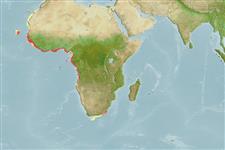>
Eupercaria/misc (Various families in series Eupercaria) >
Haemulidae (Grunts) > Haemulinae
Etymology: Pomadasys: Greek, poma, -atos = cover, operculum + Greek, dasys = with hair (Ref. 45335).
More on author: Cuvier.
Environment: milieu / climate zone / depth range / distribution range
Ekologi
laut; payau bentopelagis; kisaran kedalaman ? - 250 m (Ref. 27000), usually ? - 100 m (Ref. 27000). Tropical
Eastern Atlantic: west coast of Africa, from Senegal to Angola (Ref. 57395). Also reported from Mauritania (Ref. 5377).
Length at first maturity / Size / Weight / umur
Maturity: Lm 15.5 range ? - ? cm
Max length : 36.0 cm TL jantan/; (Ref. 5476); common length : 30.0 cm TL jantan/; (Ref. 5476)
Duri punggung (Keseluruhan (total)) : 11 - 13; duri punggung lunak (Keseluruhan (total)) : 15 - 17; Duri dubur: 3; Sirip dubur lunak: 9 - 10; vertebrata, bertulang belakang: 27. Diagnosis: body oblong and compressed; snout rather short, about equal to eye diameter; 2 anterior pores on chin, followed by a median pit bearing openings of another pair of pores (Ref. 57395). A pore above posterior end of maxilla and under preorbital bone; last dorsal spine about the same length or even shorter, exceptionally somewhat longer, than penultimate one (Ref. 81655). 2nd anal fin spine longer and stouter than 3rd (Ref. 57395, 81655), third anal spine mostly much thinner (Ref. 81655). Caudal fin forked; scales slightly ctenoid; 6-8 scale rows between lateral line and middle of spinous dorsal-fin base (Ref. 57395).
Found over sand and mud (Ref. 2683) in coastal waters (Ref. 2683, 57395). Enters estuaries and lagoons (Ref. 2135, 57395). Feeds on other fish (Ref. 5377), shrimps, crabs, mollusks, annelids, zooplankton and detritus (Ref. 28587). Often confused with P. jubelini (Ref. 57395).
Oviparous, distinct pairing during breeding (Ref. 205).
Roux, C., 1990. Haemulidae. p. 783-788. In J.C. Quero, J.C. Hureau, C. Karrer, A. Post and L. Saldanha (eds.) Check-list of the fishes of the eastern tropical Atlantic (CLOFETA). JNICT, Lisbon; SEI, Paris; and UNESCO, Paris. Vol. 2. (Ref. 6946)
Status IUCN Red List (Ref. 130435)
ancaman kepada manusia
Harmless
penggunaan manusia
Perikanan: komersial
Alat, peralatan
laporan khas
muat turun XML
Sumber internet
Estimates based on models
Preferred temperature (Ref.
123201): 15.6 - 20.8, mean 17.9 °C (based on 36 cells).
Phylogenetic diversity index (Ref.
82804): PD
50 = 0.5000 [Uniqueness, from 0.5 = low to 2.0 = high].
Bayesian length-weight: a=0.01445 (0.00668 - 0.03127), b=2.99 (2.82 - 3.16), in cm total length, based on LWR estimates for this Genus-body shape (Ref.
93245).
Trophic level (Ref.
69278): 3.3 ±0.49 se; based on food items.
Daya lenting (Ref.
120179): sedang, Waktu penggandaan populasi minimum 1.4 - 4.4 tahun (Preliminary K or Fecundity.).
Fishing Vulnerability (Ref.
59153): Low to moderate vulnerability (26 of 100).
Nutrients (Ref.
124155): Calcium = 91.5 [19.6, 181.2] mg/100g; Iron = 0.828 [0.422, 1.595] mg/100g; Protein = 17.9 [16.1, 19.8] %; Omega3 = 0.269 [0.125, 0.489] g/100g; Selenium = 69.2 [36.2, 130.1] μg/100g; VitaminA = 30.8 [13.4, 69.1] μg/100g; Zinc = 1.51 [1.03, 2.21] mg/100g (wet weight);
